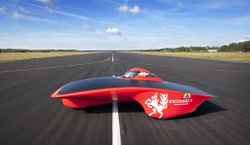
Posted to News on 17th Sep 2013, 13:53
Solar-powered car benefits from Flir thermal imaging camera
A Flir T-Series thermal imaging camera is being used by the Netherlands' Solar Team Twente team to test and monitor the performance of the car it has built for the World Solar Challenge.

Every other year since 1987 teams from across the world have been participating in the World Solar Challenge in Australia. As the competition's website advises, this is all about energy management. Based on the original notion that a 1000W car would complete the 3000km course from Darwin to Adelaide in 50 hours, the solar cars are allowed a nominal 5kW hours of stored energy. This provides around 10 per cent of the power needed, leaving the remainder to be harnessed from the sun, or recovered from the kinetic energy of the vehicle. The students in the Netherlands' Solar Team Twente are on a mission to build on its achievements in World Solar Challenge in 2011 and to further employ its use of FLIR thermal imaging that proved to be an important asset in the development of its Red Engine.
Keen to be involved in the Challenge, FLIR Systems has made one of FLIR T-Series cameras available for the team's use throughout the process. Its primary role has been to confirm all systems are working according to calculations and that they conform to the regulations specified by the organisers. Brakes are a good example.

Energy efficiency is key to winning this race and, as the team's Technical Manager, Jelle Wagenvoort advised, the less power the different components use during the race the better, as it means more power is available to drive the solar car. The FLIR T-Series camera was therefore used extensively to test electronic systems to establish which should be replaced or modified.
The solar panels are, of course, the most important part of the vehicle. Its photovoltaic cells must be reliable and operate with the utmost efficiency throughout the race. FLIR thermal imaging is suitable for this application and is now widely used commercially for this process both during the production of the panels and after their installation to ensure optimal performance.
Thermal imaging offers distinct advantages over other technologies for solar panel evaluation, as it can be used to scan panels whilst they are in operation any anomalies can be seen instantly. A complete panel can also be seen in one pass of the camera.
Dynamic field testing
The FLIR T-Series camera is suitable for dynamic testing in the field. Standard features include rotating optical block, touch screen interface and 320 x 240 pixel resolution. It can distinguish temperature changes as subtle as 0.04degC and provide precise temperature measurement from -20degC to +1500degC.
Jelle Wagenvoort concludes: "As well as for inspecting panels during the race, we will also use the camera to identify components that need cooling. This is only allowed with water at the same temperature as the environment and it is therefore very important that we identify overheating early to prevent any damage that will slow us down. With the help of thermal imaging, however, we are confident that we have developed a solar car that will give us a head start over the competition."
This year's World Solar challenge takes place from 6-13 October 2013. Solar Team Twente will be aiming to better its 2011 fifth place achievement, and thanks to FLIR Systems' recent donation of a FLIR i7 troubleshooting thermal imaging camera, that possibility is even more likely. The camera will be used to check the health of solar panels throughout the race to detect failing cells or bad connections. And for the first time in the history of this friendly competition Cambridge University Eco Racing will also be pitting its engineering skills against 28 other teams, including Solar Team Twente in its Red Engine, in the Challenger Class.
For more on the competition and to follow the progress of the teams, go to www.worldsolarchallenge.org. To learn more about thermal imaging products from Flir, please visit www.flir.com.
Want the latest machine building news straight to your inbox? Become a MachineBuilding member for free today >>


















